ROSA DE LIMA TIMELINE
1586 (April 20): Isabel Flores de Oliva was born in Lima, Peru to Gaspar Flores and María de Oliva.
1617 (August 24): Rosa de Lima died in Lima, Peru.
1671: Rosa de Lima was canonized as the first Roman Catholic saint of the Americas.
BIOGRAPHY

Born in 1586, barely fifty years after the Spanish conquest of Peru, Isabel Flores de Oliva, [Image at right] known to the world as Saint Rose of Lima (1586–1617) became the first canonized Roman Catholic saint of the Americas. Rosa’s ancestry was partly Indian, although in the social hierarchy of colonial Lima, she was considered “Spanish.” Much of the information we have about Rosa is hagiographical, that is, legendary, and was written to inspire the faithful. Nevertheless, we can piece together some important facts about her.
Living under serious economic constraints, her parents were intent on marrying Rosa to a wealthy man to capitalize on her beauty. Instead, she refused marriage adamantly, opting for the celibate religious life, although she never became a nun. She became a Dominican Tertiary like her most admired saint, Catherine of Siena (1347–1380), remaining “in the world” as a lay person. Rosa’s spirituality belonged within the long tradition of female ascetics who saw themselves imitating Jesus and his sacrifice on the cross. She surrounded herself with a group of women who devoted their lives to God, and she worked embroidering and cultivating flowers to help support her family. That she opted for virginity outside of the convent was a paradox; it challenged the expectations of her family and social context. Rosa’s refusal of both marriage and the convent, opting to become a “beata,” (which could be defined as that is a “blessed woman”) living her spiritual calling to prayer and virginity in her family’s home, gave her a special status in colonial Lima. (Some beatas were married, but their primary 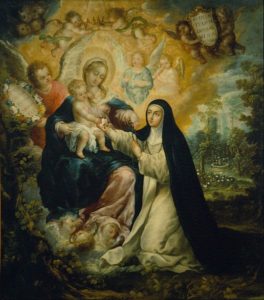 characteristic was that they did not belong to any organized group, though they lived a life of prayer and charitable endeavors.) Although financial problems may have prevented her family from providing her with the dowry needed to enter a convent, she defended her decision not to join a convent on the basis of divine intervention. She declared that the statue of the Virgin of the Rosary in the Dominican church she visited in Lima on her way to entering a convent would not allow her to rise from a kneeling position. Instead, the baby Jesus in the Virgin’s arms [Image at right] asked her to be his wife and miraculously gave her a ring that said, “Rosa de mi corazón, se tú mi esposa” (“Rose of my heart, be my wife”). By “marrying God” in this sociocultural context, she provided herself with the freedom to do what she wanted, despite apparent restrictions on her sexuality.
characteristic was that they did not belong to any organized group, though they lived a life of prayer and charitable endeavors.) Although financial problems may have prevented her family from providing her with the dowry needed to enter a convent, she defended her decision not to join a convent on the basis of divine intervention. She declared that the statue of the Virgin of the Rosary in the Dominican church she visited in Lima on her way to entering a convent would not allow her to rise from a kneeling position. Instead, the baby Jesus in the Virgin’s arms [Image at right] asked her to be his wife and miraculously gave her a ring that said, “Rosa de mi corazón, se tú mi esposa” (“Rose of my heart, be my wife”). By “marrying God” in this sociocultural context, she provided herself with the freedom to do what she wanted, despite apparent restrictions on her sexuality.
Extreme physical penances probably caused Rosa’s death when she was barely thirty. She slept on a bed of broken glass, pieces of metal, and rocks; she walked around the garden 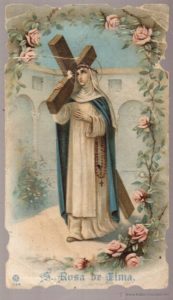 every day carrying a heavy wooden cross; [Image at right] she hung herself from her hair; she burned her hands and so on. Her inventiveness for physical self-destructive behaviors seemed inexhaustible, much to the chagrin of her mother and her confessors.
every day carrying a heavy wooden cross; [Image at right] she hung herself from her hair; she burned her hands and so on. Her inventiveness for physical self-destructive behaviors seemed inexhaustible, much to the chagrin of her mother and her confessors.
During her short life, people believed she had effected many miracles. She was particularly revered for her care of the sick and poor and for miraculous cures of Indians and African slaves. According to hagiographical accounts, she protected the city of Lima from earthquakes and an attack of pirates through the power of her prayers. The populace of Lima considered her to be a saint during her lifetime.
Her burial in 1617 nearly caused a riot; those who wanted to touch her or get some relics from her clothes were feverish with devotion. The Catholic Church confirmed popular beliefs by canonizing her as a saint in 1671. At her canonization she was declared patron saint of the Americas, India, and the Philippines by Pope Clement X (1590–1676). To this day, Rosa remains the most popular figure among Latin American saints.
Her contemporaries, and later Church authorities, thought that the extreme penances Rosa had performed since childhood pointed to her holiness. These signified her virtue and thus she was venerated. Her status as a beata and her reputation of being a living saint because of her life-threatening mortification garnered considerable prestige for her and made her a central figure in her home city of Lima.
During her lifetime and immediately after her death, her prominent cult helped to agglutinate the incipient community of Lima while the Spanish Crown promoted and used Rosa’s canonization to strengthen its empire in Latin America. She became “proof” of the benefits of the Spanish conquest of America. The Archivo de Indias in Seville holds a large stack of documents referring to all the festivities ordered by Queen Mariana (1634–1696), Regent of the Spanish throne in 1671, to celebrate Rosa’s canonization all over the territories of the Spanish Empire.
To some extent, being used by others for their own purposes is the unavoidable destiny of  anyone who becomes famous, particularly famous members of powerless groups. On the other hand, and aside from likely manipulative intent on the part of the crown and the church, the fact is that Rosa was a symbol for the populace of Lima. Through Rosa, all limeños (persons from Lima) had a “direct line to heaven,” and Lima was represented in the heavenly court, [Image at right] according to Peruvian historian Teodoro Hampe-Martínez (1997). The first saint of the Americas was a criolla, a woman of Spanish descent born on South American soil, and thus, through her, criollos had received a “seal of approval” from God. Her canonization process, where all sectors of limeña society were widely represented as witnesses and unified by their commitment to her elevation to the altars, demonstrates her symbolic value and appeal in the later construction of criollo identity. In the birth of colonial Lima and criollo identity, Rosa’s image substituted for that of the Virgen del Rosario (Our Lady of the Rosary), who had been the symbol of the Spanish conquistadores and of Rosa’s own Dominican order. Perhaps only another woman could give birth to this new identity.
anyone who becomes famous, particularly famous members of powerless groups. On the other hand, and aside from likely manipulative intent on the part of the crown and the church, the fact is that Rosa was a symbol for the populace of Lima. Through Rosa, all limeños (persons from Lima) had a “direct line to heaven,” and Lima was represented in the heavenly court, [Image at right] according to Peruvian historian Teodoro Hampe-Martínez (1997). The first saint of the Americas was a criolla, a woman of Spanish descent born on South American soil, and thus, through her, criollos had received a “seal of approval” from God. Her canonization process, where all sectors of limeña society were widely represented as witnesses and unified by their commitment to her elevation to the altars, demonstrates her symbolic value and appeal in the later construction of criollo identity. In the birth of colonial Lima and criollo identity, Rosa’s image substituted for that of the Virgen del Rosario (Our Lady of the Rosary), who had been the symbol of the Spanish conquistadores and of Rosa’s own Dominican order. Perhaps only another woman could give birth to this new identity.
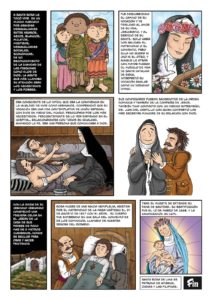
Rosa’s popularity, although transformed through the centuries, continues being central in Latin America. Modern forms of artistic representations of Rosa comprise abstract paintings and other forms of contemporary art. There are films, comic books, songs, and a plethora of scholarly articles about details of her life that demonstrate her ongoing appeal. [Image at right]
In Lima, Rosa’s house has been transformed into a museum. One can see in the central courtyard the well where Rosa threw the key to the chain she had wrapped around her waist. There is a church next to the house; its walls are decorated with paintings that represent Rosa’s dream in which she saw many maids working for Jesus in heaven by hammering at stones in a quarry. She interpreted her dream to mean simply that one must work for Jesus.
According to anthropologist Luis Millones (1993), Santa Rosa is a symbol of how Lima sees itself since colonial times. According to him, Rosa’s cult also represents all the frustrations of the populations of the Peruvian and South American Andes. During colonial times the indigenous population associated her with prophecies about liberation from the domination of the Spaniards and their descendants. During the struggle for independence in the nineteenth century, the white criollo descendants of Spaniards used her image as a symbol, while 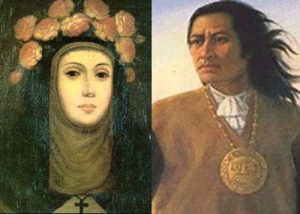 ignoring the plight of the Andean population. She has been transformed and re-transformed with time.
ignoring the plight of the Andean population. She has been transformed and re-transformed with time.
As it happens frequently in Latin America, Catholic beliefs mix and mingle with the ancestral beliefs of the indigenous populations or African slaves, thus assimilating pre-Christian traditions to the official Catholic cult. The resulting beliefs and rituals may resemble all of their antecedent sources but are in fact different and distinct. Rosa’s cult is no exception. In our time, her image appears on the tables of Andean curanderos (folk healers); she is honored and venerated next to the images of a legendary Inca rebel Túpac Amaru (1738–1781) [Image at right] who sacrificed himself for his people. The Inca rebel is a Christlike figure.
The Andean population does not view Rosa as the bride of Christ, because, as it happens with other female Catholic saints, representation of Rosa’s “marriage” to Jesus as a grown man was too evocative of sexuality. Jesus as a baby was offered to Rosa by his mother, the 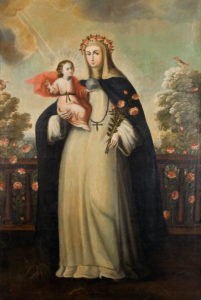 Virgen del Rosario. Thus, Rosa is frequently represented embracing a baby.[Image at right] For villagers in the Andes, Rosa is just another mother with her child. As such, she is a goddess of fertility: a woman with a child; a woman who can make the earth bear fruit. Her feast and processions are associated with fertility in the minds of the peasants, partially because her feast coincides with a very dry month in Peru.
Virgen del Rosario. Thus, Rosa is frequently represented embracing a baby.[Image at right] For villagers in the Andes, Rosa is just another mother with her child. As such, she is a goddess of fertility: a woman with a child; a woman who can make the earth bear fruit. Her feast and processions are associated with fertility in the minds of the peasants, partially because her feast coincides with a very dry month in Peru.
Variations of the cult of Rosa appear in other countries and regions. The festival of Santa Rosa in the Chilean town of Santa Rosa de Pelequén shares all the characteristics of the Peruvian Andean festivals. But the image of Santa Rosa that is taken out for the procession during her festivities in this town is dark. This is yet another transformation: a white criolla has been transformed into a dark skinned woman.
Indeed, Rosa’s cult, transformed through the centuries in Latin America, Europe, the Philippines, and possibly other areas of the world, seems to show endless possibilities. To this day, her image and story are renovated to fit the needs and conceptions of life of those who venerate her. Rosa provides a particularly graphic example of how communities construct their saints, and how saints contribute to the creation of communities and identities. Her role in the creation of Peruvian national identity is a demonstration of the importance of saints. Her canonization was the first successful Catholic attempt at acknowledging the possibility of holiness in the New World.
DOCTRINES/BELIEFS
In every respect, Rosa was a conventional Catholic Christian of her era in her devotion to Jesus, to Mary, and to the practices of the church. Any evidence to the contrary might have appeared in her notebooks, all of which have been lost. It is possible that they were deliberately destroyed by those invested in her canonization who did not want someone to find anything in her writings that could deviate from church and crown orthodoxies. Some of her paper collages were discovered at the beginning of the twentieth century, however. They reveal the importance she gave to the love of God/Jesus in her life. Some of her dreams, undoubtedly told to friends in her informal community, describe her beliefs about the importance of working to spread the word of God.
RITUALS/PRACTICES
Rosa is known, and venerated, for the severe austerities she inflicted upon herself that led to her death. These practices, so central to her identity and confession of faith, are not unproblematic, however, either then or now. As a matter of fact, some of Rosa’s penitential excesses were seen as pathological even by her contemporaries. For example, some of Rosa’s confessors believed that her supposed mystical experiences may have been due to flaqueza (weakness), desvanecimientos (dizzy spells), and melancholia (melancholy) or vahidos de cabeza, de vapores melancólicos (fainting due to melancholic vapors), rather than to virtue. Nonetheless, “Rose of Lima can be an exemplar of heroic sanctity only within a context in which her practices . . . are perceived as holy and meaningful rather than as aberrations” (Graziano 2004:8).
ISSUES/CHALLENGES
The self-mortification practiced by Rosa attracted the attention of the Inquisition, as did the activities of any woman not living in a convent or with a husband. Although the inquisitors concluded that her level of infused knowledge (that is, knowledge received directly from God without formal education) was comparable to that of trained theologians, and absolved her of all guilt, other beatas did not fare so well. Some beatas who had been in Rosa’s circle landed in the jails of the Inquisition shortly after her death, including Luisa Melgarejo, who had had an ecstatic vision at Rosa’s death bed (Iwasaki 1993). The beatas of Lima, like all women who claimed to be “visionaries” or “mystics,” but who were not in a convent or under the control of a husband or priest, raised the suspicion of religious authorities. Rosa’s place becomes more exceptional once we learn that she ended up on the altars of churches while many of her contemporaries were condemned by the Inquisition.
Regardless of how inexplicable Rosa’s behavior may seem to us today, the reality is that her behavior is not so foreign to modern women. In our time, at the beginning of a new millennium, despite differences in socio-cultural backgrounds, women frequently resort to controlling their bodies through fad dieting, plastic surgery, colonics, Spanx, or other means, which produce physical suffering, while sustaining an illusion of control over their lives. It is asserted that women “control” their bodies when they feel deprived of control in other areas of life. Research on the etiology of eating disorders, for example, clearly links those conditions to more or less desperate attempts to control one’s life (Vanderycken and van Deth 1994). In our postmodern world, women self-sacrifice and self‑torture in the name of physical attractiveness or health. Many women today engage in self-destructive behaviors for the sake of aestheticism in ways similar to what women in earlier centuries did for the sake of asceticism (Vanderycken and van Deth 1994). Then, as now, the search for perfection through the body is, for any woman, entangled with and influenced by the vicissitudes of her individual history combined with sociohistorical circumstances. Even though conscious motivations may be different in various sociohistorical contexts, the emphasis on the body as a “tool” to demonstrate self-worth continues for many women. It is not that men are not interested in their bodies, but that men have other means of becoming successful and perceived as high achievers regardless of their looks, while women, no matter what high position they may have achieved, continue to be questioned and judged by their appearance.
As it is true for women today, Rosa’s was not an either/or situation, but rather both/and. Self-mutilation and self-starvation are not only an effort made by relatively powerless women to control personal fate within the context of accepted cultural values, but also an effort to escape that lack of control. These behaviors become pathological expressions of the social expectations imposed on women that intertwine with individual women’s life histories. The damaging consequences of cultural norms that inspire self-destructive behaviors in women should be explored and analyzed. And, although it is important to problematize these behaviors as a manifestation of the negative messages and limited options available to women, it is just as important to not simply pathologize the behavior by looking at it from our perspective several centuries later. We need to see the similarities in women’s behavior toward their bodies in our own time and at the possible socio-psychological causes and consequences then and now.
Father Guillermo Alvarez, one of Rosa’s twentieth century biographers (1992), believes that her inability to express in any other way her solidarity with the suffering of the indígenas (the indigenous people of Peru), which she must have witnessed repeatedly, led to her extreme self-mutilation and self-torture. He sees Rosa’s extreme penances as an embodied protest against injustice (albeit the helpless protest of a woman deprived of other means of expression) rather than as some psychological deficiency or tendency to masochism inherent in her as an individual.
There is yet another unexplored possibility that may or may not be applicable to Rosa or to any other ascetic woman. I hesitate to speculate about this because of the danger of ahistoricizing experience and their emotional meanings. However, I cannot avoid thinking as a psychologist when confronted with these extreme cases of physical self-destruction. I am referring to the possibility that some of these behaviors may have been a consequence of childhood physical abuse. Researchers have been able to trace adult self-destructive behavior to its traumatic childhood origins (e.g., Favazza 1996; Van der Kolk 2015). Abused children tend to grow up confusing love and pain and believing that one necessarily involves the other. Attempting to control the effect of damaging experiences, they sometimes resort to self-mutilation (e.g., Favazza 1996; Van der Kolk 2015). We know from Rosa’s history that she received severe physical punishment as a child from both her mother and her grandmother every time she responded to being called by the name each one of them had chosen for her. Baptized as Isabel, the name of her grandmother, her mother and an Indian servant took to calling her Rosa because her beauty resembled the beauty of roses. During her childhood, every time she responded when called Rosa, her grandmother beat her up, and every time she responded to the name Isabel, her mother did the same. Since they called her by one or another name multiple times during a given day, she was beaten by one or another of these two women every time she obediently responded to a call. Needless to say, a powerful message about how one deserves to be treated is conveyed to a child who receives multiple beatings every day throughout childhood. Did this experience influence Rosa’s extreme physical self-abuse? If yes, are similar experiences responsible for the presumed asceticism of so many other women saints? This may not be such an absurd proposition if we consider how widespread the abuse of girls and women continues to be today.
As author Sara Maitland (1990) posits, even though “[t]his sort of ‘fanatical’ asceticism is currently not well received in intellectual theological circles” (1990:61), Rose of Lima did not view herself as having a problem. “Even if we now find it difficult to accept that these were real or substantial recompenses for the life she had chosen to live we cannot reasonably question that she did” (1990:63).
It is next to impossible to determine what the real motivations for her extreme self‑destruction were. But what is certain is that she took it upon herself to control her destiny, including inviting death, rather than leave that control in the hands of others. She did so in the only and rather contorted way available to her in her specific cultural and religious context. In this endeavor, no matter how submissive to authority she appeared to have been, she presumed to have a life, a body, an identity apart from male authority and from cultural definitions of what should constitute femininity. She showed her determination to pursue her own goals, perceived by her as God’s will. Despite her bizarre means of self‑assertion, her lack of conformity and her autonomous decision‑making remain clear to us now despite the hagiographers’ efforts to make her appear as an accommodating and submissive woman. The story of Rosa and other women saints’ lives suggest that women, though constrained by difficult circumstances and despite having limited resources, may resort to bold, even apparently self-destructive measures, to assert their own capacity for action and to resist. She lived against the grain of societal scripts, while limited in her choices by those same scripts. Then as now, the crux, for each woman, is in the specific intersection of subjectivity and social power. And in finding ways in which her personal experience of oppression could be harnessed and subverted.
IMAGES
Image #1: Santa Rosa de Lima by Claudio Coello (1642–1693), Spanish Baroque painter. 1683. Prado National Museum.
Image #2: Los desposorios misticos de santa Rosa de Lima [The Mystic Betrothal of Saint Rose of Lima] by Nicolás Correa (1660–ca. 1720). 1691. San Diego Viceregal Painting Gallery.
Image #3: S. Rosa de Lima card.
Image #4: Santa Rosa de Lima, facial reconstruction by 3D designer Cicero Moraes for Convento de Santo Domingo in Lima, Peru.
Image #5: Santa Rosa de Lima. Comic book depiction.
Image #6: Depictions of Santa Rosa de Lima and Túpac Amaru.
Image #7: Santa Rosa de Lima with Child Jesus by Anonymous, Cusco School. Ca.1680–ca. 1700. Lima Art Museum.
Image #8: Procession of Santa Rosa de Lima in Pelequén, 2015.
REFERENCES
Alvarez, Guillermo 1992. Santa Rosa de Lima: Una realización de la vocación cristiana. Lima, Perú: Convento de Santo Domingo.
Favazza, Armando, ed. 1996. Bodies under Siege: Self-mutilation and Body Modification in Culture and Psychiatry. Baltimore: Johns Hopkins University Press.
Graziano, Frank. 2004. Wounds of Love: The Mystical Marriage of Saint Rose of Lima. New York: Oxford University Press.
Hampe-Martínez, Teodoro. 1997. “Los testigos de Santa Rosa. (Una aproximación social a la identidad criolla en el Perú colonial)” [Santa Rosa’s witnesses. (A social approximation to “criollo” identity in colonial Peru)]. Revista Complutense de Historia de América 2:113–36.
Iwasaki, Fernando. 1993. “Mujeres al borde de la perfección: Rosa de Santa María y las alumbradas de Lima” [Women at the edge of perfection: Rosa de Santa Maria and the illuminist women of Lima]. Hispanic American Historical Review 73:581–613.
Maitland, Sara. 1990. “Rose of Lima: Some Thoughts on Purity and Penance.” Pp. 60-70 in Through the Devil’s Gateway: Women, Religion and Taboo, edited by Alison Joseph. London: SPCK.
Millones, Luis. 1993. Una partecita del cielo [A little bit of heaven]. Lima: Editorial Horizonte.
Van der Kolk, Bessel. 2015. The Body Keeps the Score: Brain, Mind, and Body in the Healing of Trauma. New York: Penguin Books.
Vanderycken, Walter, and Ron van Deth. 1994. From Fasting Saints to Anorexic Girls: A History of Self-Starvation. New York: New York University Press.
Weinberg, Cybelle, Táki Athanássios Cordás, and Patricia Albornoz Muñoz. 2005. “Saint Rose of Lima: An Anorexic Saint in Latin America?” Revista de Psiquiatria do Rio Grande do Sul 27:51–56.
SUPPLEMENTARY RESOURCES
Espín, Oliva M. 2014. “Saints in the Cuban Heat.” Pp. 102-12 in Fleshing the Spirit: Spirituality and Activism in Chicana, Latina, and Indigenous Women’s Lives, edited by Elisa Facio and Irene Lara. Tucson: University of Arizona Press.
Espín, Oliva M. 2012. “The Interplay of Criollo Identity, Colonial Politics, and Gender in the Enduring Popular Appeal of Rose of Lima.” Pp. 355-65 in Agiografia e culture popolari /Hagiography and popular culture, ed. Paolo Golinelli. Verona, Italy: Universita degli Studi di Verona.
Espín, Oliva M. 2011. “The Enduring Popularity of Rosa de Lima, First Saint of the Americas: Women, Bodies, Sainthood, and National Identity.” Cross Currents 6:6–27.
Espín, Oliva M. 2011. “Female Saints: Submissive or Rebellious? Feminists in Disguise?” Pp. 135-64 in Innsbrucker Gender Lectures I, edited by Doris Eibl, Marion Jarosch, Ursula A. Schneider, and Annette Steinsiek. Innsbruck, Austria: Innsbruck University Press.
Hampe-Martínez, Teodoro. 1999. “Santa Rosa de Lima y la identidad criolla en el Perú colonial (ensayo de interpretación).” Pp. 95-114 in Mujeres y género en la historia del Perú. Lima, Perú: CENDOC-Mujer.
Post date:
29 October 2018
